Experimental and Analytical Investigation of Self-Centering Precast Composite Walls with Sloped Plane Friction Dampers
Abstract
:1. Introduction
2. The Details of the Self-Centering Wall and SPFDs
3. Experimental Program
3.1. Specimen Description
3.2. Construction Procedure
3.3. Materials
3.4. Test Setup and Measurement System
4. Results and Discussion
4.1. Failure Modes
4.2. Hysteretic Curves
4.3. Stiffness Degradation and Strength
4.4. Energy Dissipation Capacity
4.5. Residual Drift
4.6. Horizontal Joint Behavior
4.7. PT Tendon Behavior
5. Analysis Method
6. Summary and Conclusions
- The maximum residual drift of the self-centering walls with SPFDs was 0.28%, demonstrating great self-centering capacity. The energy dissipation capacity of the wall met the requirements with a relative energy dissipation ratio greater than 0.125, indicating great energy dissipation capacity. The damage to the walls was slight, meaning they exhibited great low-damage characteristics.
- Due to the strengthening effect of the steel wall toes, the bearing capacity of the wall remained increased, and the neutral axis length did not increase significantly even at large drift, distinguishing it from walls without steel jackets. Moreover, the increasing friction force of the SPFDs with drift contributed to improving energy dissipation capacity compared to both self-centering walls without dampers and walls with flat plate friction dampers.
- The SPFDs remained undamaged at large drift, unlike metal dampers which were prone to damage under similar conditions. Consequently, the bearing capacity, energy dissipation capacity, and residual drift of the wall with SPFDs did not decrease at large drift.
- The initial PT force obviously influenced the residual drift and horizontal bearing capacity. Owing to a 57% higher initial PT force in PW2 compared to PW1, PW2 demonstrated a 13% reduction in residual drift and a 16% increase in bearing capacity relative to PW1.
- The initial prestressing clamping force significantly influenced the energy dissipation capacity. The initial prestressing clamping force of PW3 was twice that of PW2, resulting in the relative energy dissipation ratio of PW3 being 1.2 times that of PW2.
- The theoretical analysis of the friction of the SPFDs and lateral force of the self-centering wall was carried out and compared with the experimental results. The method can predict the horizontal bearing capacity of the walls reasonably well.
- Future research should be performed to evaluate the effect of the combined form of CBS and the dimensions of steel wall toes on the seismic behavior of the walls. Furthermore, the seismic behavior and structural design method of self-centering wall structure should be studied.
Author Contributions
Funding
Institutional Review Board Statement
Informed Consent Statement
Data Availability Statement
Conflicts of Interest
References
- Kurama, Y.C.; Sritharan, S.; Fleischman, R.B.; Restrepo, J.I.; Henry, R.S.; Cleland, N.M.; Ghosh, S.K.; Bonelli, P. Seismic-resistant precast concrete structures: State of the art. J. Struct. Eng. 2018, 144, 03118001. [Google Scholar] [CrossRef]
- Aaleti, S.; Sritharan, S. A simplified analysis method for characterizing unbonded post-tensioned precast wall systems. Eng. Struct. 2009, 31, 2966–2975. [Google Scholar] [CrossRef]
- Bournas, D.A.; Negro, P.; Molina, F.J. Pseudodynamic tests on a full-scale 3-storey precast concrete building: Behavior of the mechanical connections and floor diaphragms. Eng. Struct. 2013, 57, 609–627. [Google Scholar] [CrossRef]
- Seifi, P.; Henry, R.S.; Ingham, J.M. Panel connection details in existing New Zealand precast concrete buildings. Bull. New Zealand Soc. Earthq. Eng. 2016, 49, 190–199. [Google Scholar] [CrossRef]
- Xu, G.S.; Wang, Z.; Wu, B.; Bursi, O.S.; Tan, X.J.; Yang, Q.B.; Wen, L. Seismic performance of precast shear wall with sleeves connection based on experimental and numerical studies. Eng. Struct. 2017, 150, 346–358. [Google Scholar] [CrossRef]
- Kurama, Y.; Pessiki, S.; Sause, R.; Lu, L.-W. Seismic behavior and design of unbonded post-tensioned precast concrete walls. PCI J. 1999, 44, 72–89. [Google Scholar] [CrossRef]
- Rahman, A.M.; Restrepo-Posada, J.I. Earthquake Resistant Precast Concrete Buildings: Seismic Performance of Cantilever Walls Prestressed Using Unbonded Tendons; University of Canterbury: Christchurch, New Zeland, 2000. [Google Scholar]
- Restrepo, J.I.; Rahman, A. Seismic performance of self-centering structural walls incorporating energy dissipators. J. Struct. Eng. 2007, 133, 1560–1570. [Google Scholar] [CrossRef]
- Smith, B.J.; Kurama, Y.C.; McGinnis, M.J. Design and measured behavior of a hybrid precast concrete wall specimen for seismic regions. J. Struct. Eng. 2011, 137, 1052–1062. [Google Scholar] [CrossRef]
- Smith, B.J.; Kurama, Y.C.; McGinnis, M.J. Perforated hybrid precast shear walls for seismic regions. ACI Struct. J. 2015, 112, 359–370. [Google Scholar] [CrossRef]
- Liu, Y.; Zhou, W. Experimental investigation of self-centering hybrid concrete shear walls subjected to horizontal cyclic loading. Earthq. Eng. Struct. Dyn. 2021, 50, 3754–3770. [Google Scholar] [CrossRef]
- Marmiott, D.; Pampanin, S.; Palemo, A.; Bull, D. Shake-table testing of hybrid post-tensioned precast wall systems with alternative dissipating solutions. In Proceedings of the 14th World Conference on Earthquake Engineering, WCEE, Beijing, China, 12–17 October 2008. [Google Scholar]
- Marriott, D.; Pampanin, S.; Bull, D.; Palermo, A. Dynamic testing of precast, post-tensioned rocking wall systems with alternative dissipating solutions. Bull. New Zealand Soc. Earthq. Eng. 2008, 41, 90–103. [Google Scholar] [CrossRef]
- Li, X.H.; Wu, G.; Kurama, Y.C.; Cui, H.R. Experimental comparisons of repairable precast concrete shear walls with a monolithic cast-in-place wall. Eng. Struct. 2020, 216, 110671. [Google Scholar] [CrossRef]
- Bedriñana, L.A.; Tani, M.; Kono, S.; Nishiyama, M. Evaluation of the seismic performance of unbonded post-tensioned precast concrete walls with internal and external dampers. I: Experimental research. J. Struct. Eng. 2022, 148, 04022105. [Google Scholar] [CrossRef]
- Bedriñana, L.A.; Tani, M.; Kono, S.; Nishiyama, M. Evaluation of the Seismic Performance of Unbonded Post-Tensioned Precast Concrete Walls with Internal and External Dampers. II: Design Criteria and Numerical Research. J. Struct. Eng. 2022, 148, 04022106. [Google Scholar] [CrossRef]
- Brown, J.R.; Li, M.; Palermo, A.; Pampanin, S.; Sarti, F. Experimental testing of a low-damage post-tensioned C-shaped CLT core-wall. J. Struct. Eng. 2021, 147, 04020357. [Google Scholar] [CrossRef]
- Chen, Z.Y.; Popovski, M.; Iqbal, A. Structural Performance of Post-Tensioned CLT Shear Walls with Energy Dissipators. J. Struct. Eng. 2020, 146, 04020035. [Google Scholar] [CrossRef]
- Mugabo, I.; Barbosa, A.R.; Sinha, A.; Higgins, C.; Riggio, M.; Pei, S.; van de Lindt, J.W.; Berman, J.W. System identification of UCSD-NHERI shake-Table test of two-Story structure with cross-laminated timber rocking Walls. J. Struct. Eng. 2021, 147, 04021018. [Google Scholar] [CrossRef]
- Twigden, K.M.; Sritharan, S.; Henry, R.S. Cyclic testing of unbonded post-tensioned concrete wall systems with and without supplemental damping. Eng. Struct. 2017, 140, 406–420. [Google Scholar] [CrossRef]
- Nazari, M.; Sritharan, S. Dynamic evaluation of PreWEC systems with varying hysteretic energy dissipation. J. Struct. Eng. 2018, 144, 04018185. [Google Scholar] [CrossRef]
- Nazari, M.; Sritharan, S. Seismic design of precast concrete rocking wall systems with varying hysteretic damping. PCI J. 2019, 64, 58–76. [Google Scholar] [CrossRef]
- Twigden, K.M.; Henry, R.S. Shake table testing of unbonded post-tensioned concrete walls with and without additional energy dissipation. Soil. Dyn. Earthq. Eng. 2019, 119, 375–389. [Google Scholar] [CrossRef]
- Nazari, M.; Sritharan, S. Influence of different damping components on dynamic response of concrete rocking walls. Eng. Struct. 2020, 212, 110468. [Google Scholar] [CrossRef]
- Naserpour, A.; Fathi, M. A posttensioned rocking infill wall–frame system for multistory precast concrete buildings. Struct. Des. Tall Special Build. 2021, 30, e1833. [Google Scholar] [CrossRef]
- East, M.; Yassin, A.; Ezzeldin, M.; Wiebe, L. Development of Controlled Rocking Masonry Walls with Energy Dissipation Accessible in a Steel Base. J. Struct. Eng. 2023, 149, 04023032. [Google Scholar] [CrossRef]
- Cui, H.R.; Wu, G.; Zhang, J.; Xu, J.H. Experimental study on damage-controllable rocking walls with resilient corners. Mag. Concr. Res. 2019, 71, 1113–1129. [Google Scholar] [CrossRef]
- Moghaddam, S.H.; Shooshtari, A. Nonlinear static and dynamic behaviors assessment of self-centering post-tensioned concrete wall with multiple-slit device. J. Build. Eng. 2021, 43, 102999. [Google Scholar] [CrossRef]
- Wu, H.H.; Sui, L.; Zhou, T.H.; Huang, B.; Li, X.H. A novel self-centering energy-dissipating wall panel with framed beams as boundaries. Eng. Struct. 2021, 232, 111864. [Google Scholar] [CrossRef]
- Cui, Y.; Shu, Z.; Zhou, R.; Li, Z.; Chen, F.; Ma, Z. Self-centering steel–timber hybrid shear wall with slip friction dampers: Theoretical analysis and experimental investigation. Struct. Des. Tall Special Build. 2020, 25, e1789. [Google Scholar] [CrossRef]
- Liu, Y.; Zhou, W.; Xie, X. Experimental study of precast self-centering concrete shear walls with external friction dampers. J. Build. Eng. 2023, 68, 106182. [Google Scholar] [CrossRef]
- Du, X.L.; Wang, Z.Y.; Liu, H.T.; Liu, M.M. Research on seismic behavior of precast self-centering concrete walls with dry slip-friction connectors. J. Build. Eng. 2021, 42, 102668. [Google Scholar] [CrossRef]
- Hashemi, A.; Zarnani, P.; Masoudnia, R.; Quenneville, P. Seismic resistant rocking coupled walls with innovative Resilient Slip Friction (RSF) joints. J. Constr. Steel Res. 2017, 129, 215–226. [Google Scholar] [CrossRef]
- Tatar, A.; Dowden, D.M. Analytical and numerical investigation of a low-damage uplift friction damper for self-centering cross-laminated timber rocking walls. Eng. Struct. 2022, 254, 113836. [Google Scholar] [CrossRef]
- Lepine-Lacroix, S.; Yang, T.Y. Seismic design and performance evaluation of novel dual-pinned self-centering coupled CLT shear walls. Eng. Struct. 2023, 279, 115547. [Google Scholar] [CrossRef]
- Darani, F.M.; Zarnani, P.; Quenneville, P. Development of a new self-centring structural connector for seismic protection of structures. J. Constr. Steel Res. 2022, 189, 107064. [Google Scholar] [CrossRef]
- ACI ITG-5.1-07; Acceptance Criteria for Special Unbonded Post-Tensioned Precast Structuralwalls Based on Validation Testing and Commentary. American Concrete Institute: Farmington Hills, MI, USA, 2007.
- JGJ 92-2016; Technical Specification for Concrete Structures Prestressed with Unbonded Tendons. China Architecture & Building Press: Beijing, China, 2016.
- Lin, X. Study on Gravity Anchorage Structure and Replaceable Main Cable Anchorage System of Super-Long Span Suspension Bridges; Southeast University: Nanjing, China, 2022. [Google Scholar]
- Hashemi, A.; Masoudnia, R.; Quenneville, P. Seismic performance of hybrid self-centring steel-timber rocking core walls with slip friction connections. J. Constr. Steel Res. 2016, 126, 201–213. [Google Scholar] [CrossRef]
- Guo, T.; Zhang, G.; Chen, C. Experimental Study on Self-Centering Concrete Wall with Distributed Friction Devices. J. Earthq. Eng. 2013, 18, 214–230. [Google Scholar] [CrossRef]
- GB 50010-2010; MOHURD. Code for Design of Concrete Structures. Ministry of Housing and Urban-Rural Development of the People’s Republic of China: Beijing, China, 2010.
- GB/T 2281-2010; AQSIQ and SAC. Metallic Materials-Tensile Testing-Part 1: Method of Test at Room Temperature. The General Administration of Quality Supervision, Inspection and Quarantine of the People’s Republic of China (AQSIQ) and the Standardization Administration (SAC) of the People’s Republic of China: Beijing, China, 2010.
- Schoettler, M.J.; Belleri, A.; Dichuan, Z.; Restrepo, J.I.; Fleischman, R.B. Preliminary results of the shake-table testing for the development of a diaphragm seismic design methodology. PCI J. 2009, 54, 100–124. [Google Scholar] [CrossRef]
- JGJ3-2010; MOHURD. Technical Specification for Concrete Structures of Tall Building. Ministry of Housing and Urban-Rural Development of the People’s Republic of China: Beijing, China, 2010.
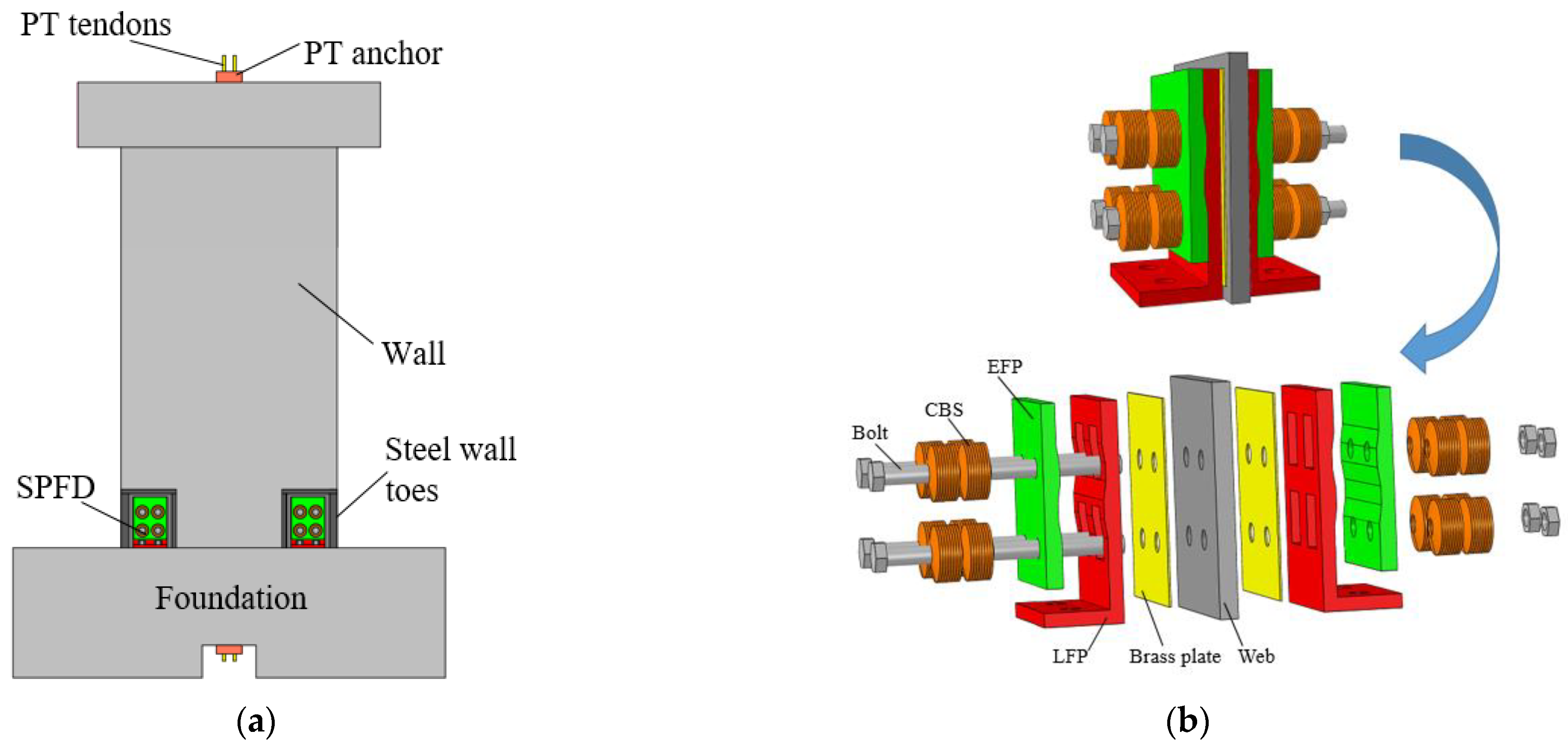
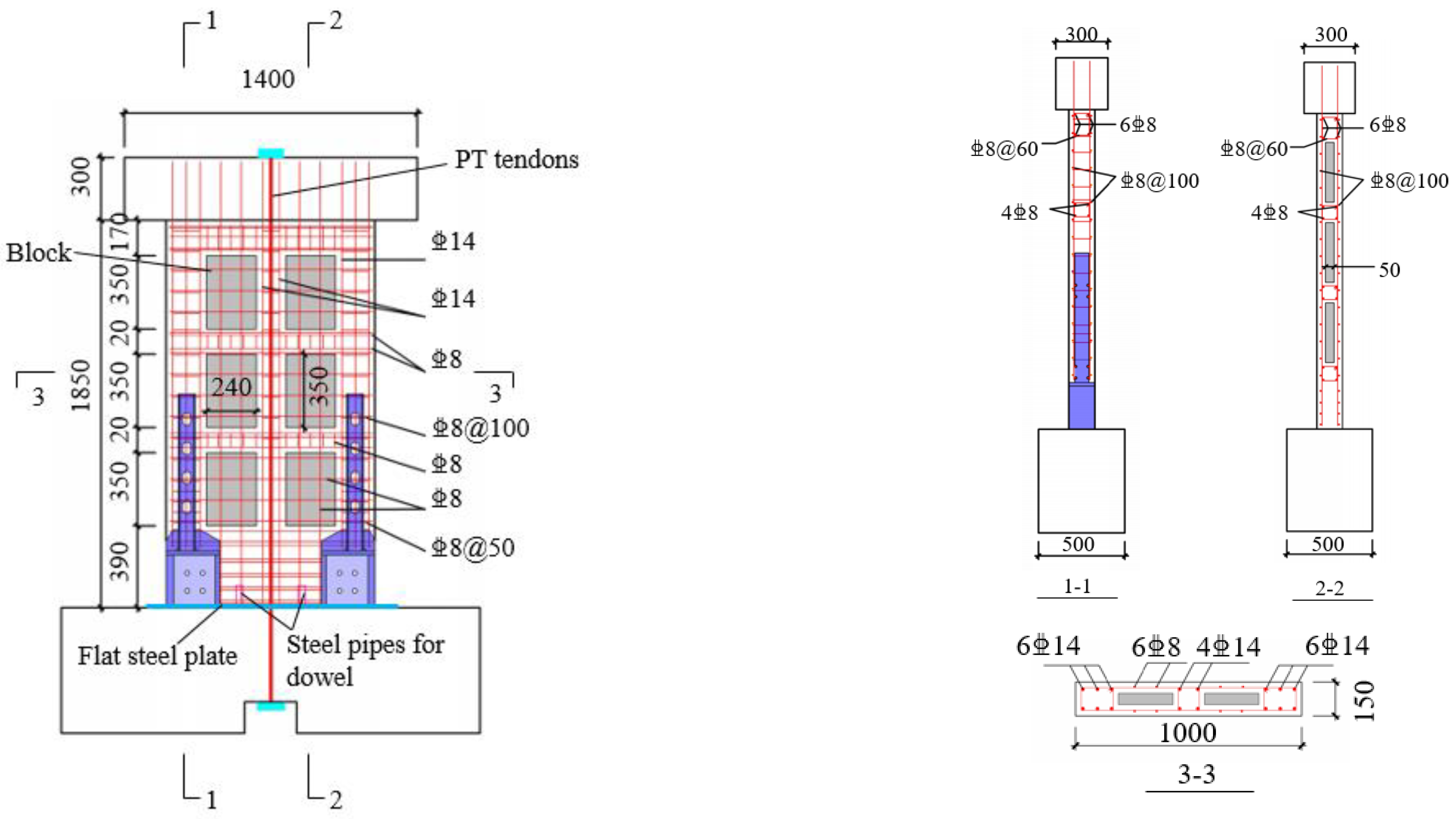
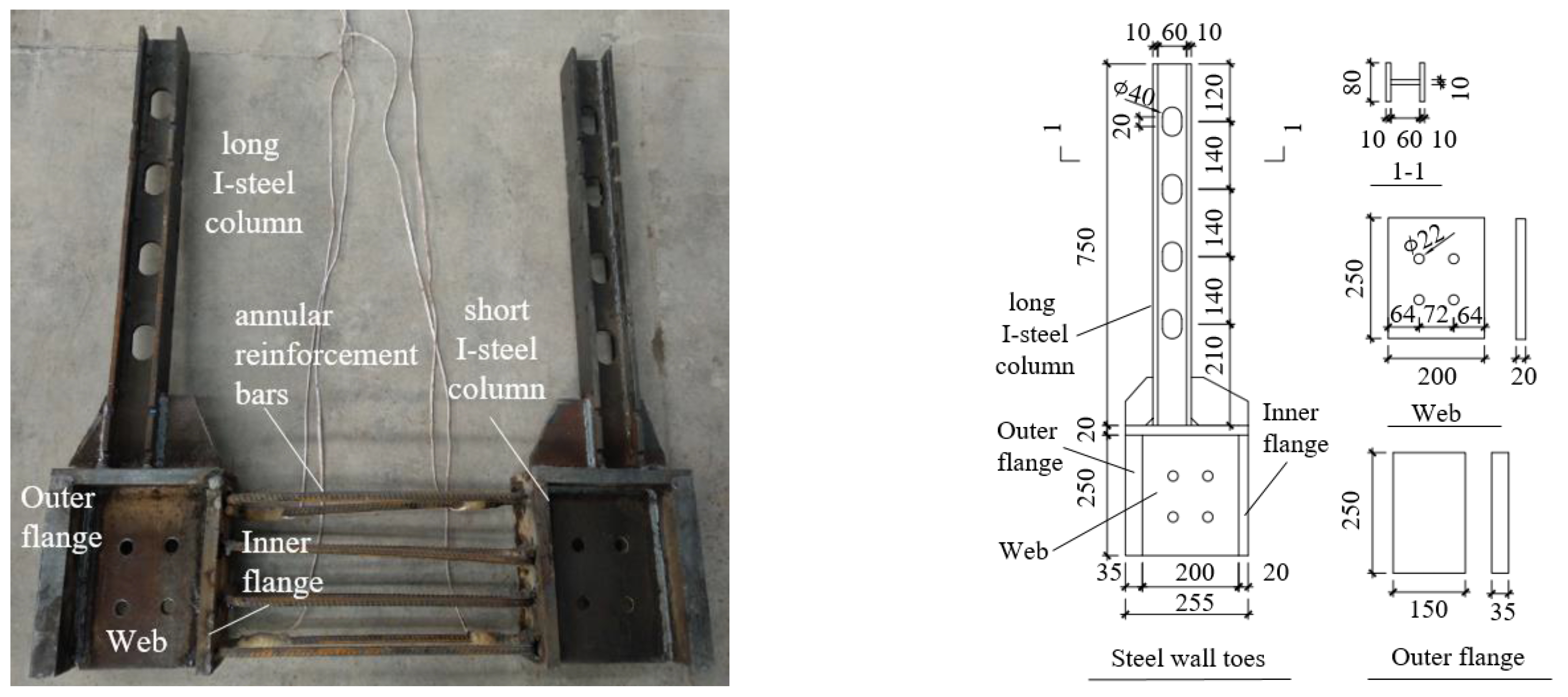
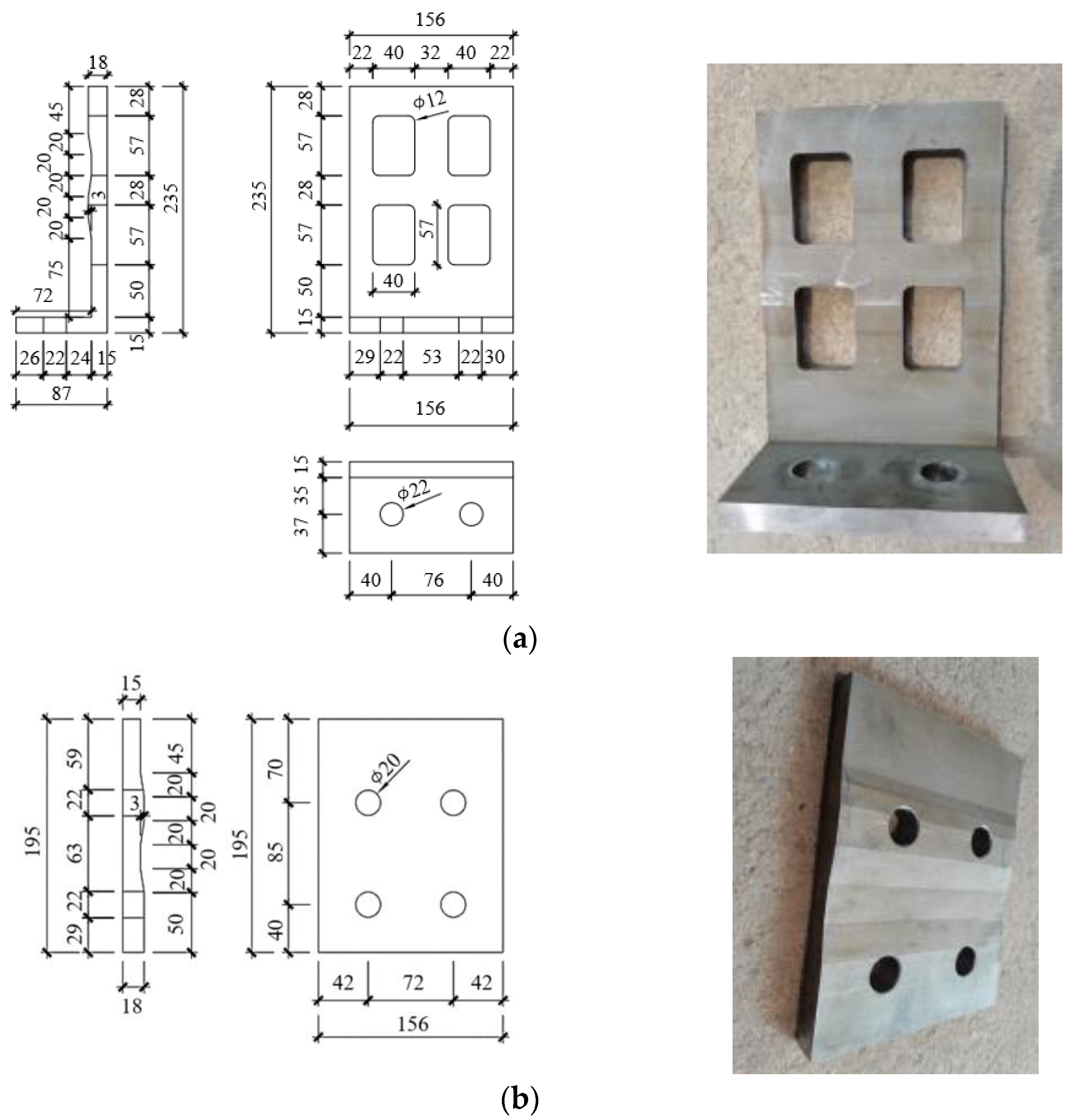


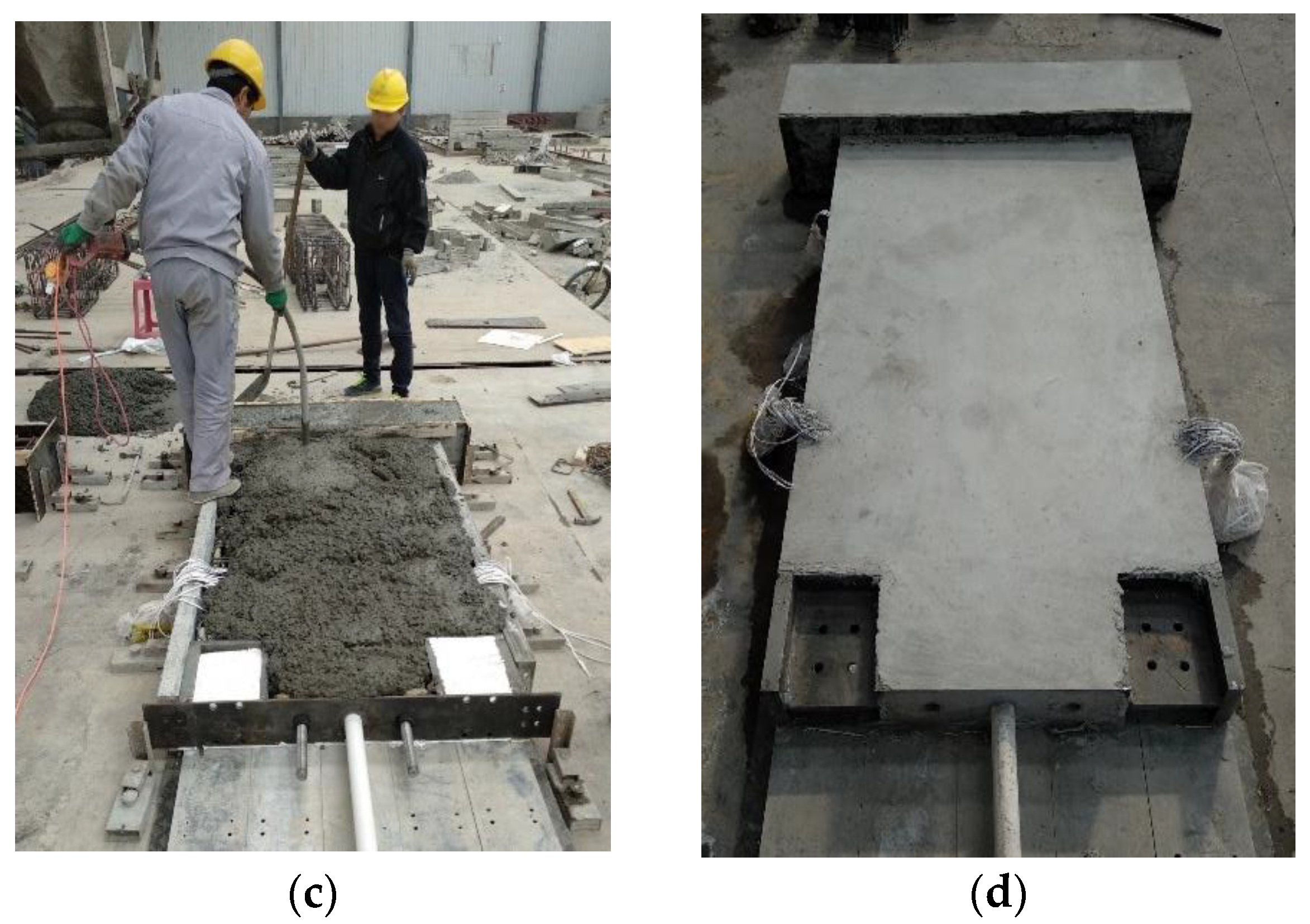

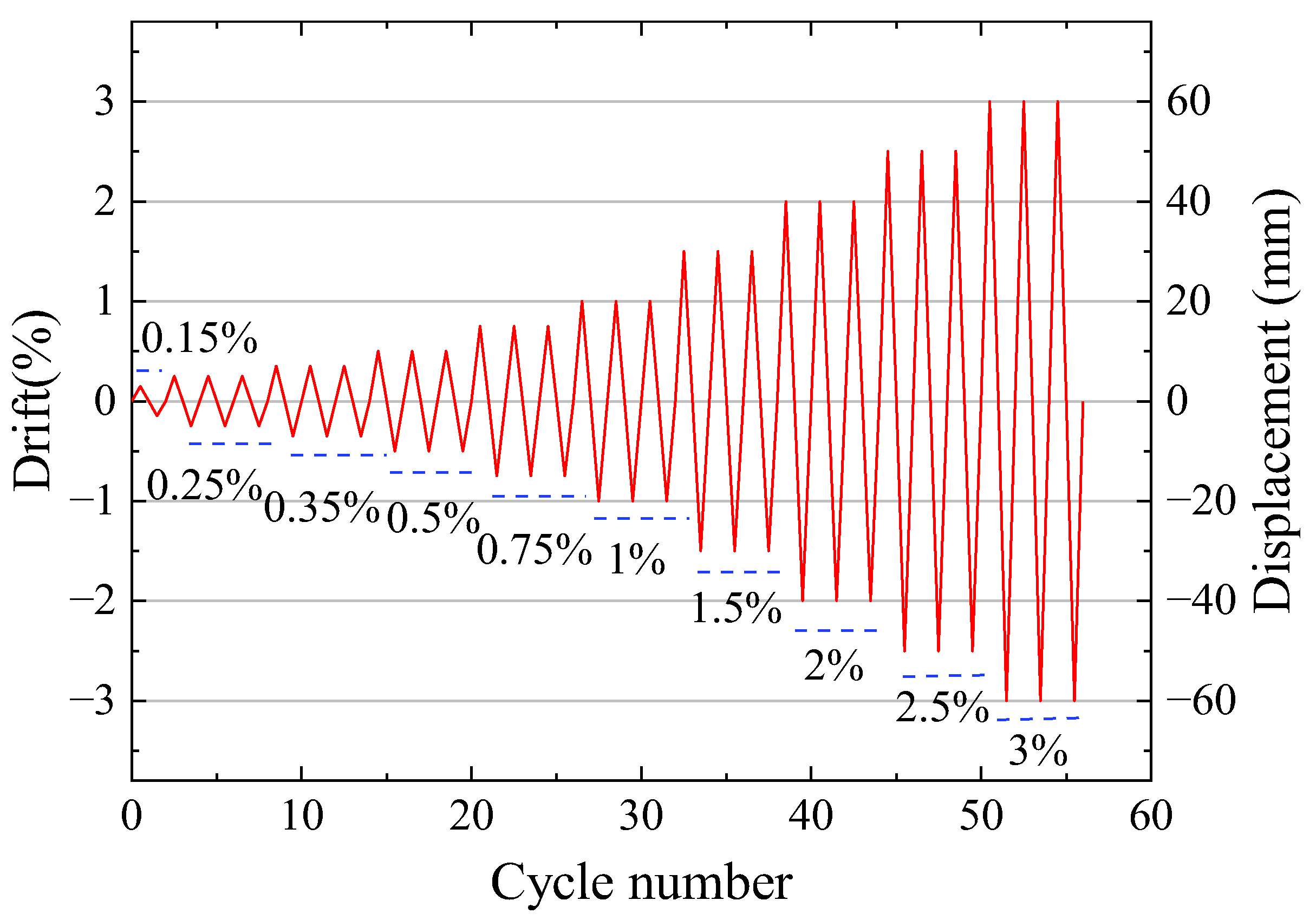


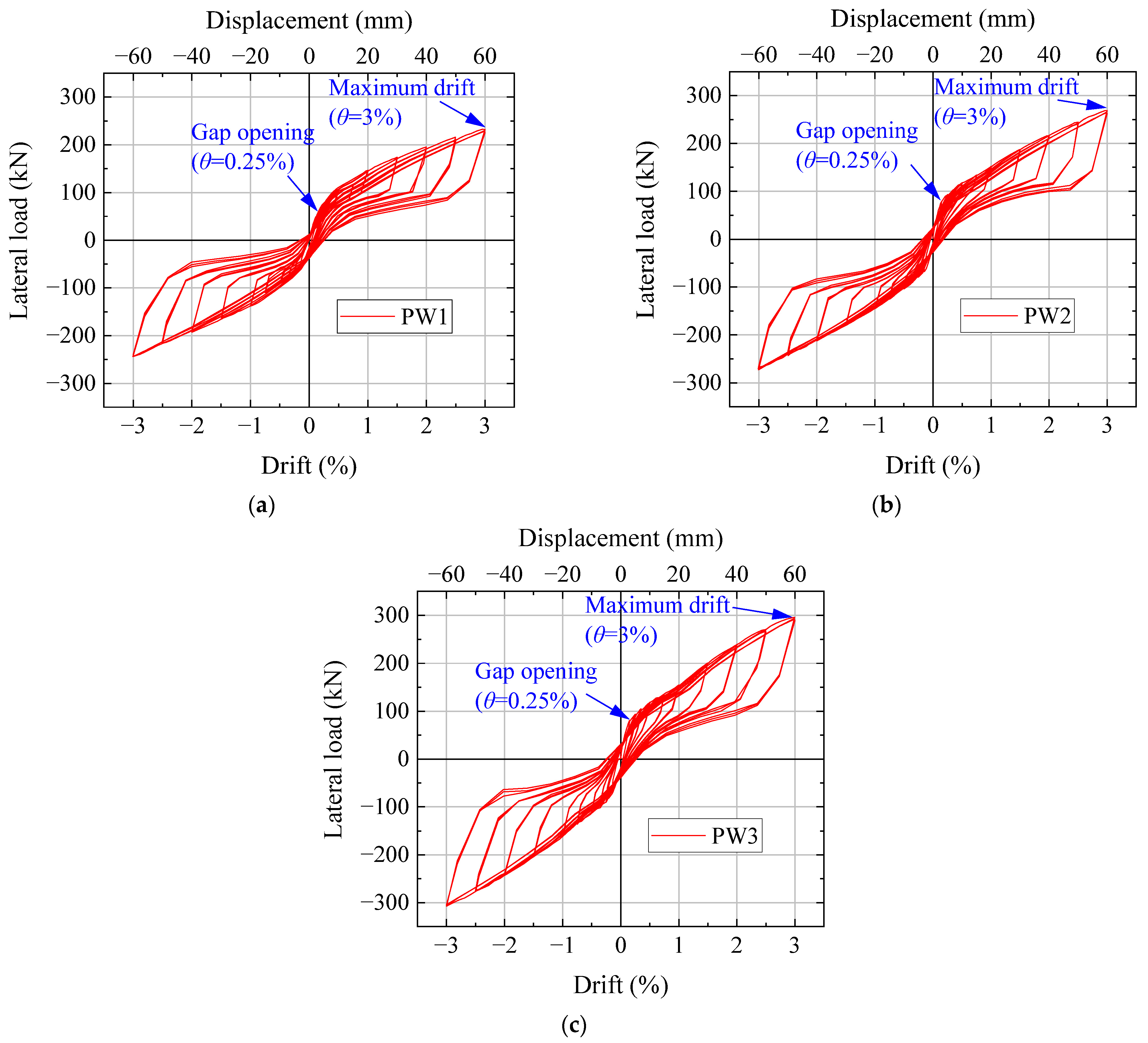
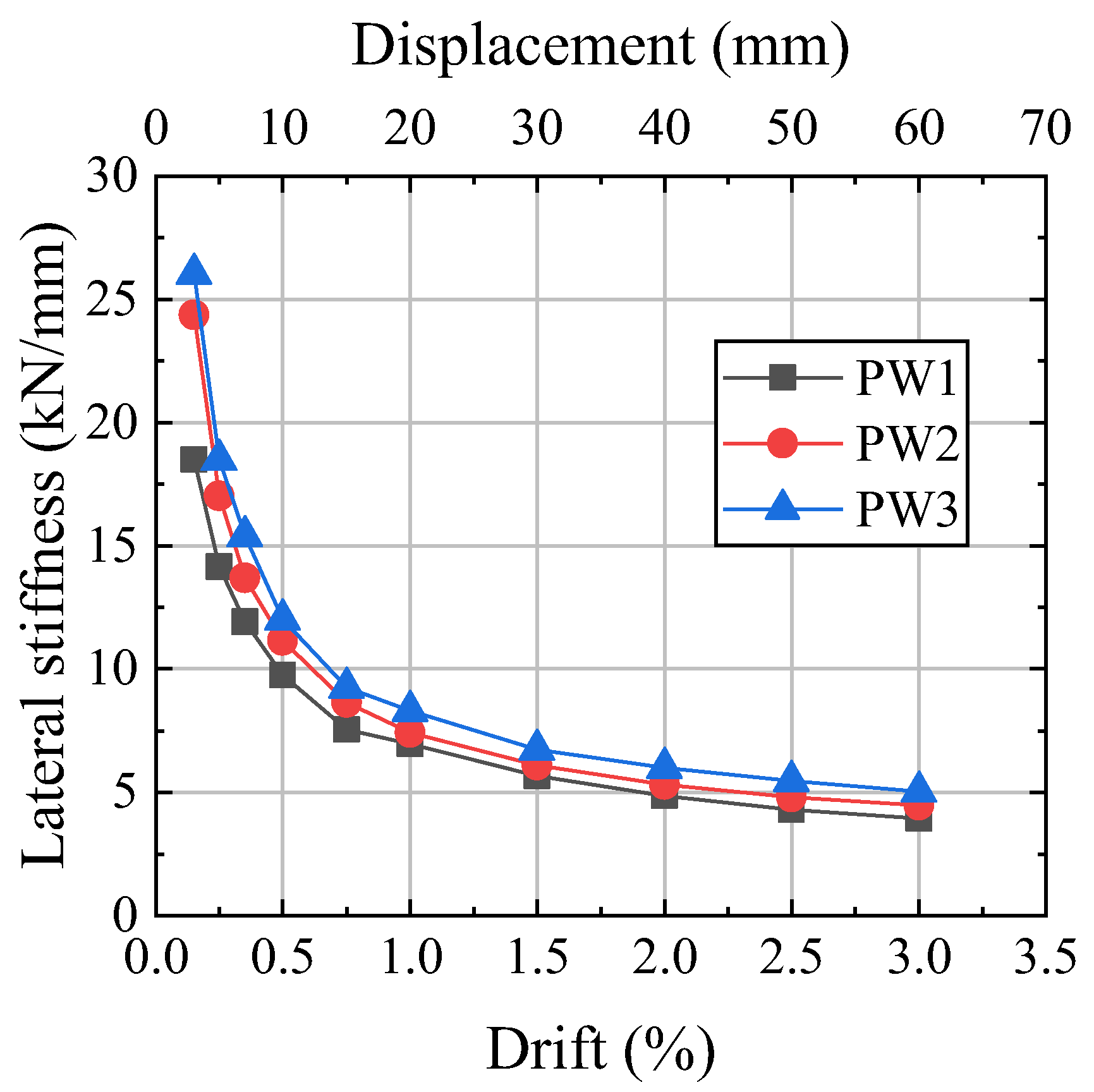
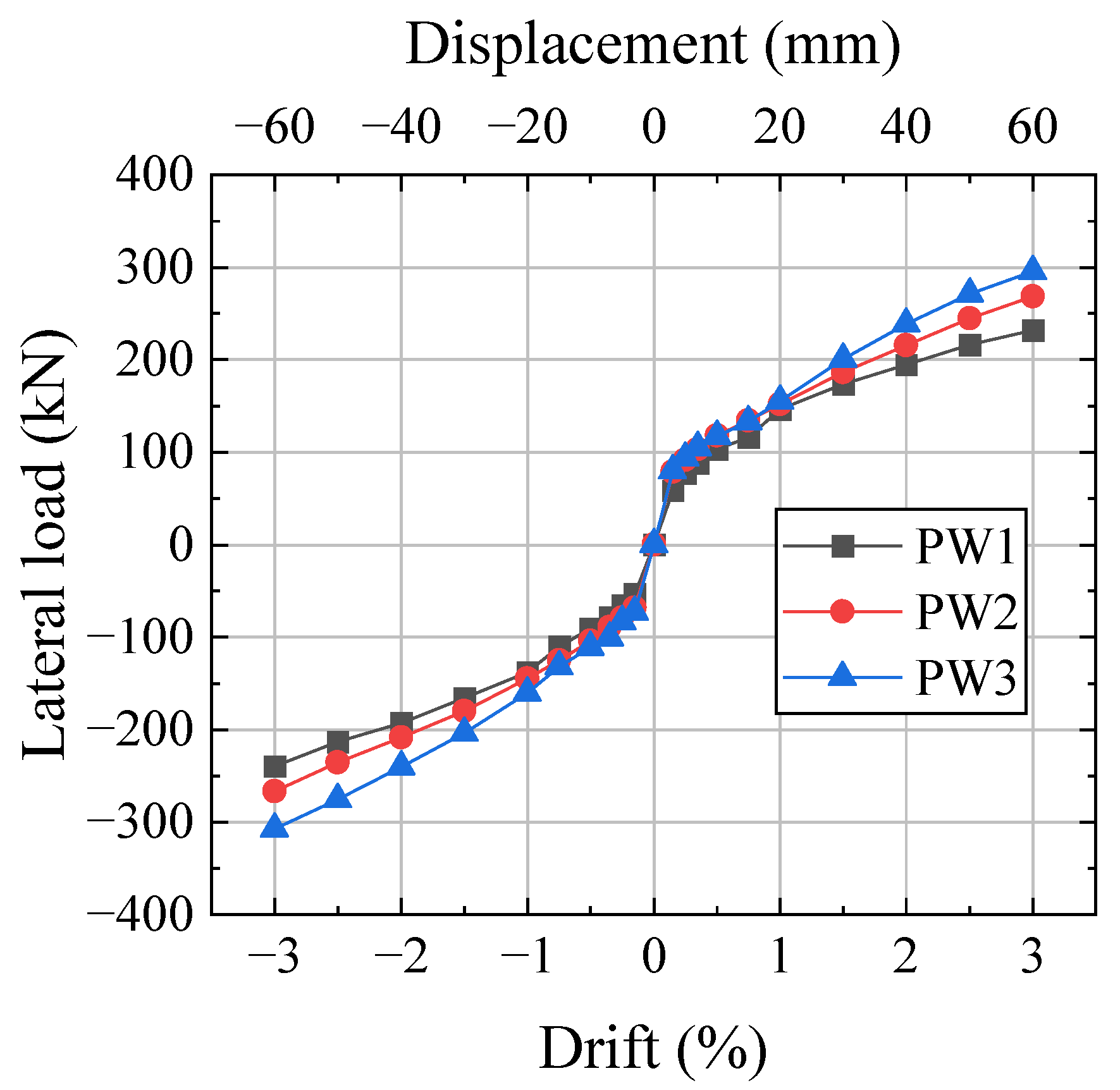
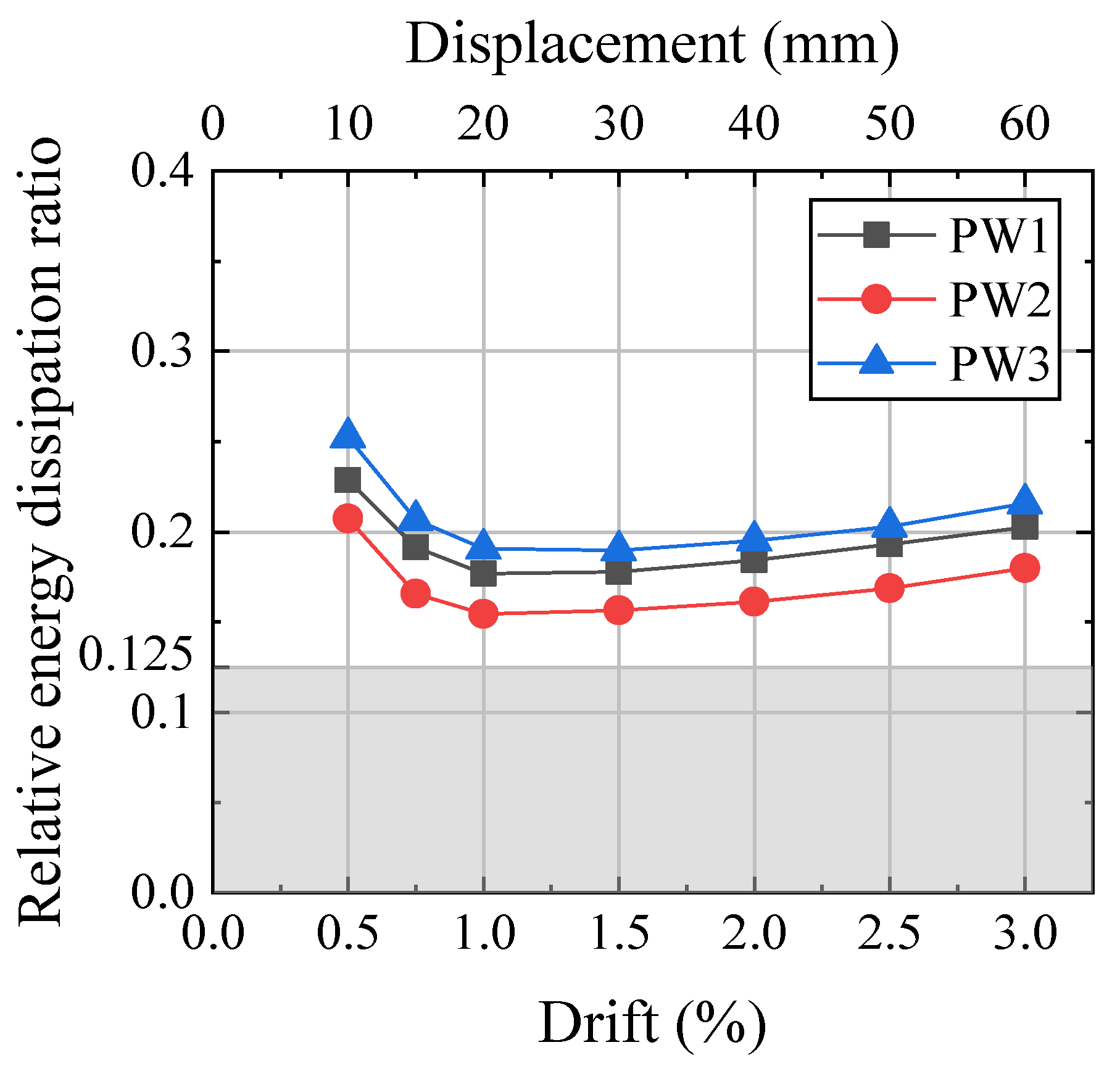
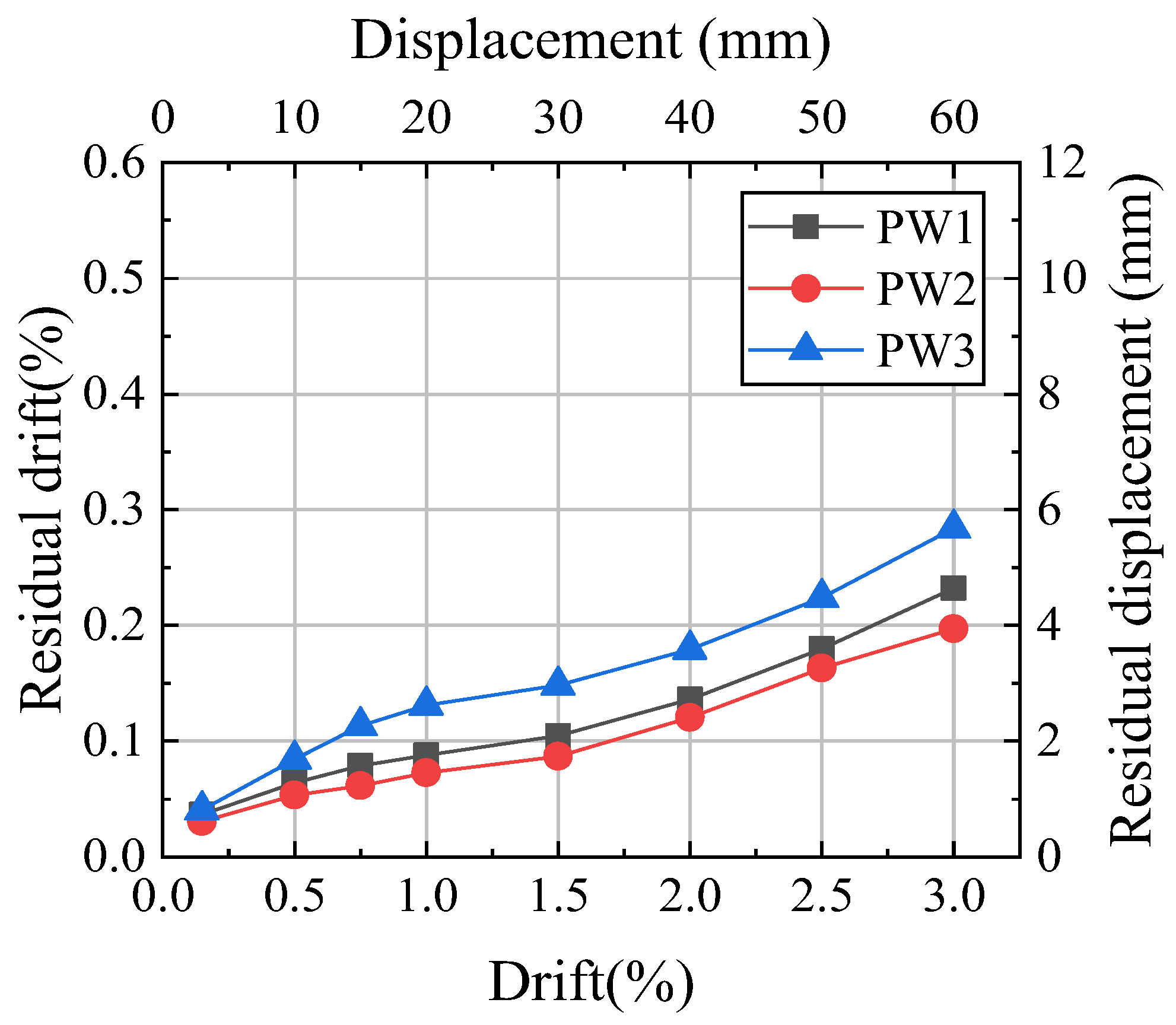

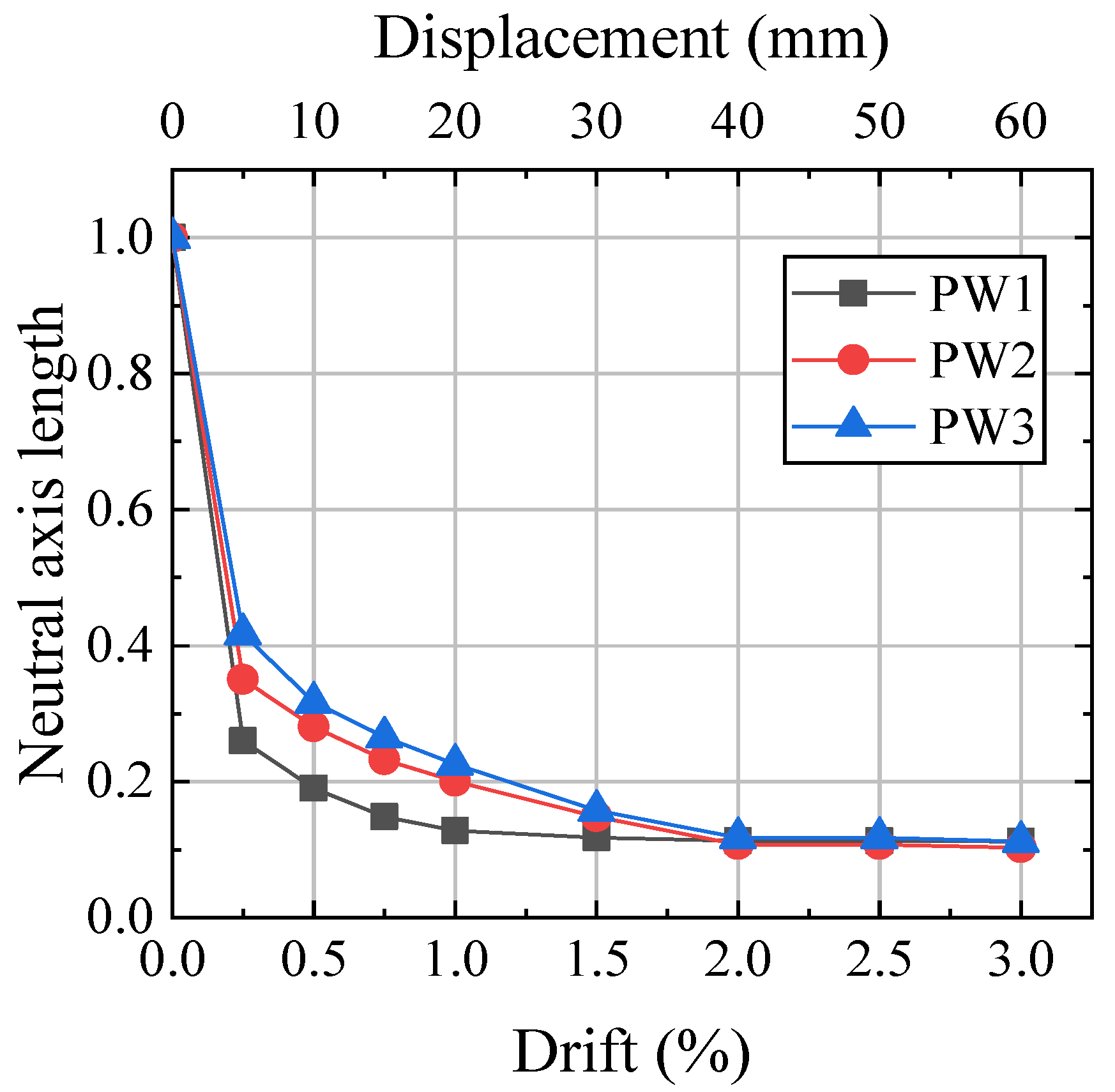

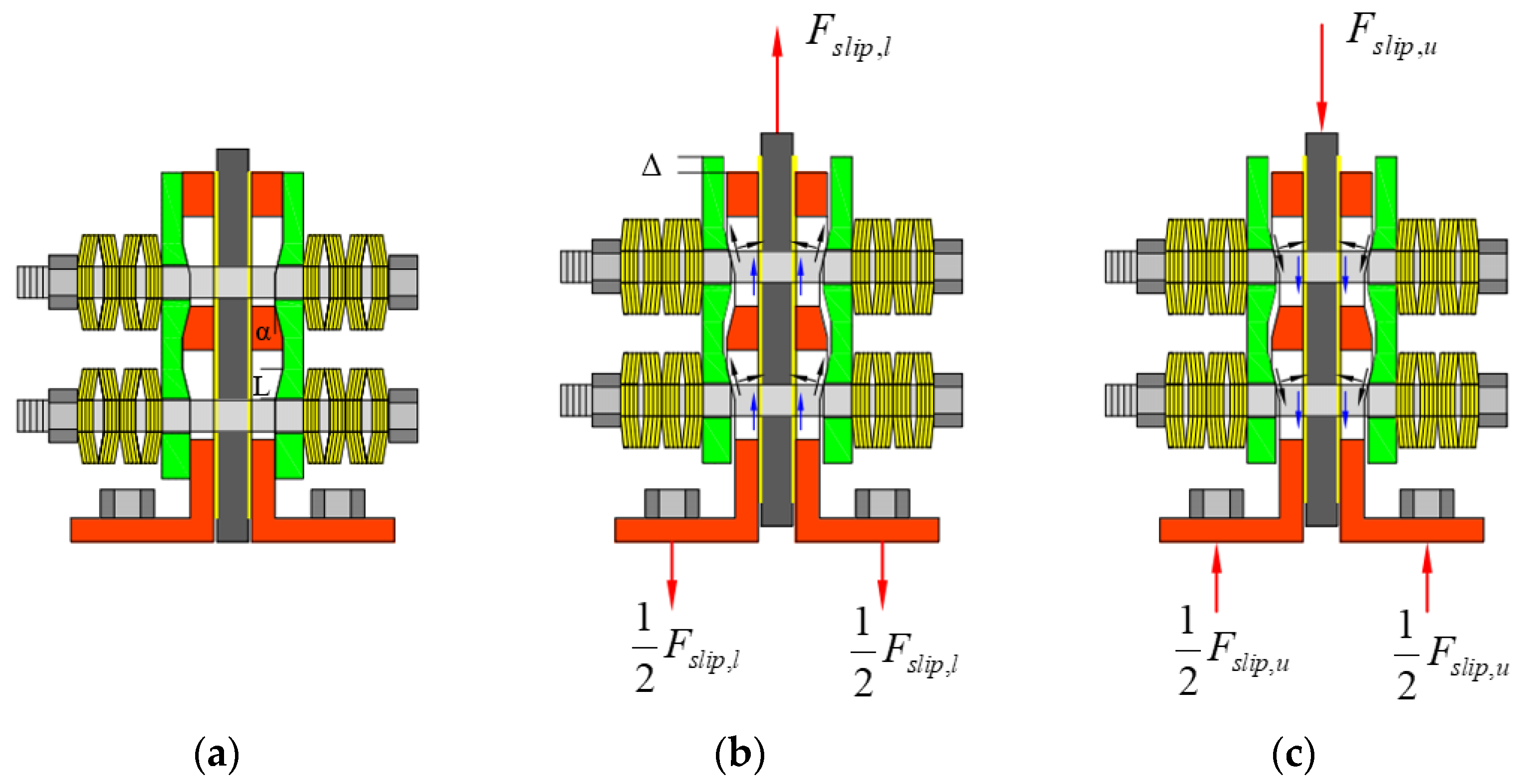

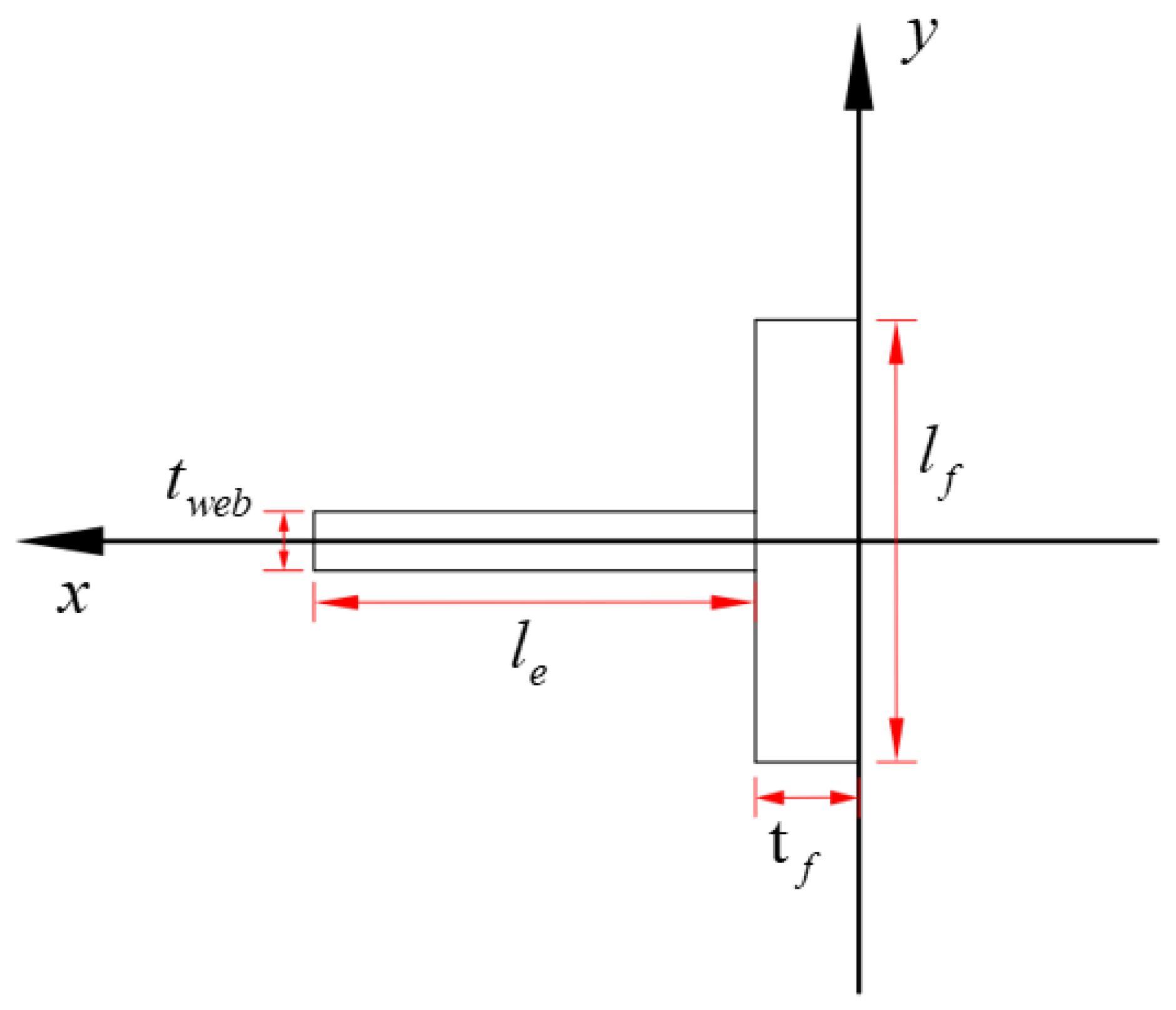
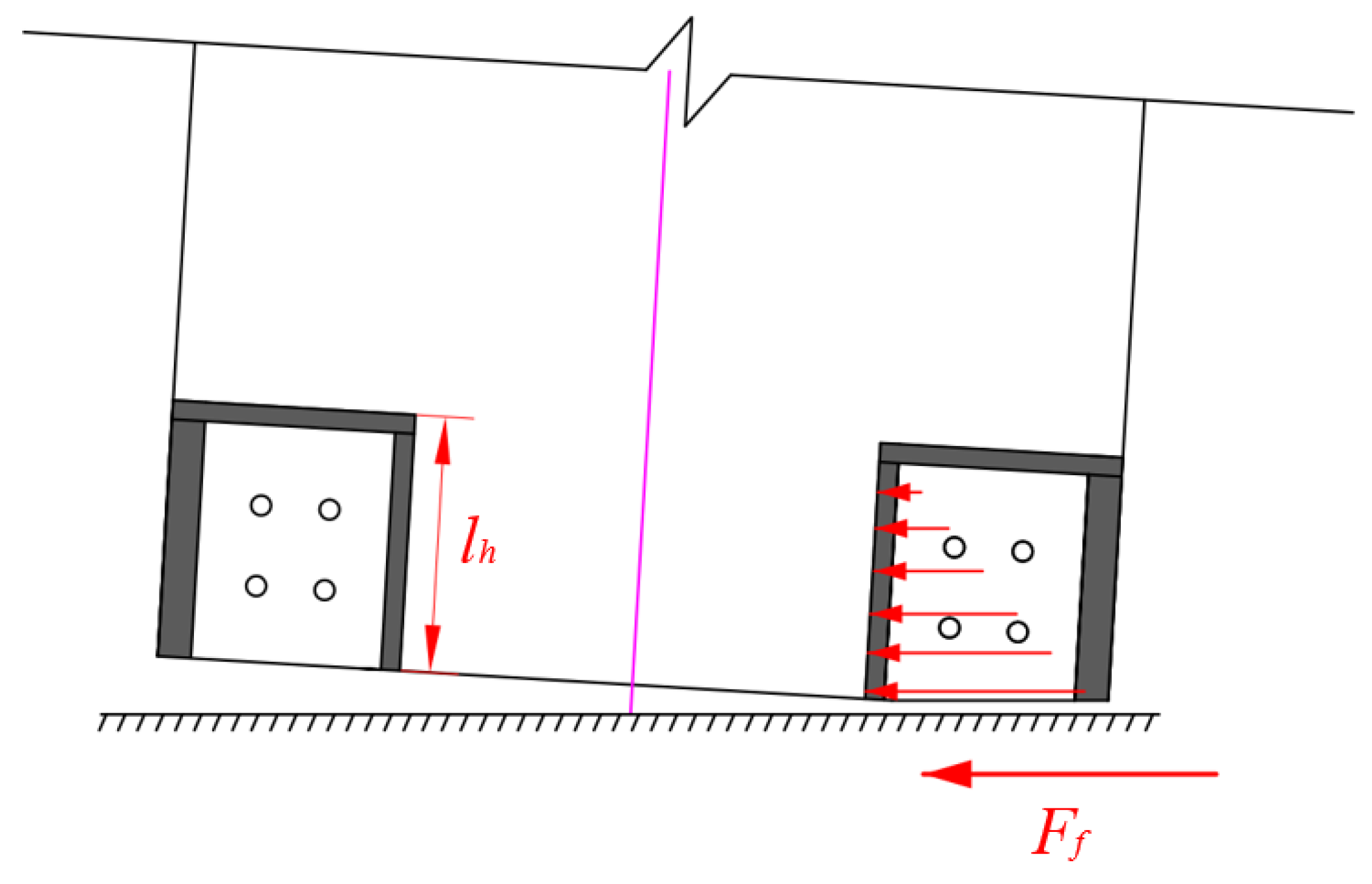
| Specimen | FPT,0 (kN) | T (N·mm) | μN |
|---|---|---|---|
| PW1 | 300 | 44 | 0.102 |
| PW2 | 407 | 44 | 0.137 |
| PW3 | 398 | 88 | 0.134 |
| Material | Type | Yield Strength (MPa) | Tensile Strength (MPa) |
|---|---|---|---|
| Steel plates | Q345 | 400 | 530 |
| PT tendons | 1860 grad | 1670 | 1860 |
| Bolts | 10.9 grad | 900 | 1000 |
| Reinforcing bars | HRB 400 | 430 | 590 |
| Specimen | PW1 | PW2 | PW3 | |
|---|---|---|---|---|
| FO | FO,exp (kN) | 77.24 | 92.07 | 93.92 |
| FO,the (kN) | 82.14 | 96.45 | 101.14 | |
| ηO | 6.34% | 4.76% | 7.69% | |
| Fmax | Fmax,exp (kN) | 231.76 | 268.76 | 295.77 |
| Fmax,the (kN) | 233.28 | 255.21 | 280.40 | |
| ηmax | 0.66% | 5.04% | 5.19% | |
Disclaimer/Publisher’s Note: The statements, opinions and data contained in all publications are solely those of the individual author(s) and contributor(s) and not of MDPI and/or the editor(s). MDPI and/or the editor(s) disclaim responsibility for any injury to people or property resulting from any ideas, methods, instructions or products referred to in the content. |
© 2024 by the authors. Licensee MDPI, Basel, Switzerland. This article is an open access article distributed under the terms and conditions of the Creative Commons Attribution (CC BY) license (https://creativecommons.org/licenses/by/4.0/).
Share and Cite
Huang, W.; Fan, Z.; Liu, K.; Hu, G.; Miao, X.; Sun, Y.; Liu, G. Experimental and Analytical Investigation of Self-Centering Precast Composite Walls with Sloped Plane Friction Dampers. Materials 2024, 17, 1319. https://doi.org/10.3390/ma17061319
Huang W, Fan Z, Liu K, Hu G, Miao X, Sun Y, Liu G. Experimental and Analytical Investigation of Self-Centering Precast Composite Walls with Sloped Plane Friction Dampers. Materials. 2024; 17(6):1319. https://doi.org/10.3390/ma17061319
Chicago/Turabian StyleHuang, Wei, Zhenhui Fan, Kang Liu, Gaoxing Hu, Xinwei Miao, Yujiao Sun, and Gang Liu. 2024. "Experimental and Analytical Investigation of Self-Centering Precast Composite Walls with Sloped Plane Friction Dampers" Materials 17, no. 6: 1319. https://doi.org/10.3390/ma17061319




